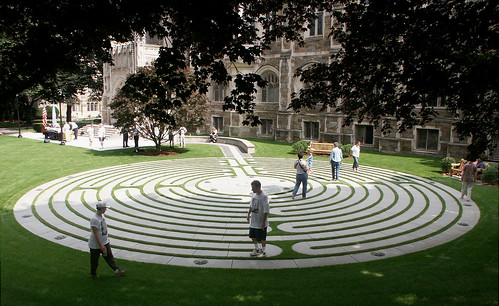This. The surrounding brick takes away from the contrast of the grass and stone. Also the exterior "floating" stone paths that aren't attached to the labyrinth itself make it feel out of place, really only attempt to cover up the lack of space, and add distracting clutter that takes away from the clean feel.
Despite this I still like it.
Hutch -- the original "non-ancient" labyrinths were in Medeivil Cathedrals with the contrast just sufficient for you to grasp the theological significance
from the wiki-- " The full flowering of the medieval labyrinth came about from the twelfth through fourteenth centuries with the grand pavement labyrinths of the gothic cathedrals, notably Chartres, Reims and Amiens in northern France. These labyrinths may have originated as symbolic allusion to the Holy City; and some modern thinkers have theorized that prayers and devotions may have accompanied the perambulation of their intricate paths. "
- I think a labyrinth in the midst of the Greenway will be one of the highpoints -- it still needs a grand Sundial
from the wiki on Commonwealth Ave -- "Often compared to Georges-Eugène Haussmann's Paris boulevards, Commonwealth Avenue in Back Bay is a parkway divided at center by a wide grassy mall. This greenway, called Commonwealth Avenue Mall, is punctuated with statuary and memorials, and forms the narrowest "link" in the Emerald Necklace. It connects the Public Garden to the Fens."
and from the cityofboston website
"The Mall's 32 acres were designed in the French boulevard style by Arthur Gilman in 1856. Frederick Law Olmsted and Charles Sprague Sargent, partners in creating the Arnold Arboretum, were asked in 1880 for advice on tree planting patterns. Their suggestion was "to obtain . . . the uniformity which seems to us essential to the future beauty and dignity of the finest street in the city." removing the trees already planted and replacing them with two single rows of European elms. Fearing public outcry at losing existing trees, the City Council rejected the proposal. Still, the Mall was known for magnificent American elms, some of which survive the Dutch Elm disease that devastated the species in recent decades.
Today, sweetgum, green ash, maple, linden, zelkova, Japanese pagoda and elm define this formal avenue, along with monuments decorating its expansive central promenade. "
All the greenway needs -- people living nearby and some time for things to evolve
Riff is mostly off target!




